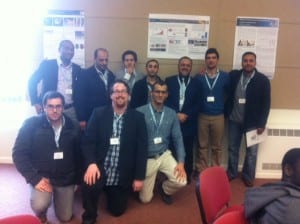The monthly PGRs Research Presentations was held on Wed. 13th November, 2pm, Room MC0025 (Ground floor).
This session we had the following presentations:
| Title: “Shaping human-aware navigation and human-robot joint motion using long-term adaptation“. |
|
Title: “Data Analysis of Agent-based Crowd Simultion” |
|
By: Christian Dondrup
|
|
By: Qinbing Fu
|
| Abstract:Enabling a mobile service robot to move in a human populated environment is not only a question of safety but also of predictability, consistency, team work efficiency, and the general feeling of comfort of the human. This leads to a form of human-robot joint motion and human-aware navigation which is supposed to be most pleasant for the people involved. There are currently many approaches of solving this issue but most of them are built on constraints and static learning methods and not on long-term learning through interaction. The main focus of this thesis is therefore the creation of novel approaches to shape a robots spatial behaviour ”on-the-fly” using long-term experiences from engagements in joint movements with lay users and trying to find and understand adaptation needs and thereby create a predictable, readable and consistent robot behaviour.This first presentation will focus on state-of-the-art methods of social and human-aware navigation and a first study conducted to find gestures indicating adaptation needs to improve the feeling of comfort of human interaction partners and the likabilaty of the robot itself. |
|
Abstract: This work is based on clustering and visualizing an agent-based crowd simulation data in an airport, using K-means, Gaussian Mixture Model and Hidden Markov Model. With the help of these models, we mainly aim to verify the feasibility of our approach to analyse agents’ behaviour in the airport. |
|
|
|
The meeting started by welcoming the new PGRs arrived.
After presentations and Q/A sessions, the meeting continued with:
* Congratulations Talal Al-Bacha, for his new baby girl.
* Brief information on the “Students Representative” duties/responsibilities/benefits.
* Election of the PGRs Students Representatives: 2 nominations and 2 positions available (based on a Rep for each 25 PGR).
* Students Reps for this academic year are: Christian Dondrup and Touseef Qureshi.
* Discussion about potential activities (social, trips,…etc.)
